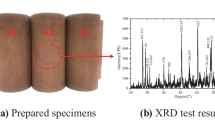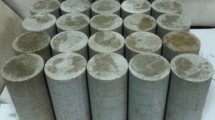Abstract
A series of triaxial compression experiments of intact and cracked sandstone with different degrees of damage were carried out using a rock mechanics servo-controlled system. Based on the experimental results, the influence of the confining pressure and damage on the peak strength, residual strength parameters, deformation parameters, and failure modes of cracked sandstone was investigated in detail. The results show that the strength and deformation behavior depends on not only the confining pressure but also the damage. The peak and residual strength of intact and cracked specimens increases linearly with increasing confining pressure, which is in good agreement with the linear Mohr-Coulomb criterion. The peak strength and equivalent cohesion of cracked specimens decreases linearly and exponentially with increasing damage, respectively. However, the internal friction angle is independent of damage. The elastic and secant modulus of cracked specimens increases linearly with increasing confining pressure but decreases with increasing damage. Then the effects of the confining pressure and damage on the peak strain and failure modes of cracked specimens are also analyzed in detail, indicating the transition of the failure modes from single shear failure to multiple shear failure with increasing damage.
















Similar content being viewed by others
References
Alejano LR, Alonso E (2005) Considerations of the dilatancy angle in rocks and rock masses. Int J Rock Mech Min Sci 42(4):481–507
Alonso E, Alejano LR, Varas F, Fdez-Manin G, Carranza-Torres C (2003) Ground response curves for rock masses exhibiting strain-softening behaviour. Int J Numer Anal Meth Geomech 27(13):1153–1185
Cheng C, Chen X, Zhang SF (2016) Multi-peak deformation behavior of jointed rock mass under uniaxial compression: insight from particle flow modeling. Eng Geol 213:25–45
Duda M, Renner J (2013) The weakening effect of water on the brittle failure strength of sandstone. Geophys J Int 192(3):1091–1108
Fairhurst CE, Hudson JA (1999) Draft ISRM suggested method for the complete stress-strain curve for the intact rock in uniaxial compression. Int J Rock Mech Min Sci 36(3):279–289
Fang Z, Harrison JP (2001) A mechanical degradation index for rock. Int J Rock Mech Min Sci 38(8):1193–1199
Frantziskonis G, Desai CS (1987) Constitutive model with strain softening. Int J Solids Struct 23(6):733–750
Gatelier N, Pellet F, Loret B (2002) Mechanical damage of an anisotropic rock under cyclic triaxial tests. Int J Rock Mech Min Sci 39(3):335–354
Han LJ, Yang MJ (2009) Re-fracture process and mechanical characteristics of cracked rock samples. Int J Min Sci Technol 46(4):738–747
Hashiba K, Fukui K (2015) Effect of water on the deformation and failure of rock in uniaxial tension. Rock Mech Rock Eng 48(5):1751–1761
Jing HW, Su HJ, Yang DL, Wang C, Meng B (2012) Study of strength degradation law of damaged rock sample and its size effect. Chin J Rock Mech Eng 31(3):543–549
Jing L (2003) A review of techniques, advances and outstanding issues in numerical modelling for rock mechanics and rock engineering. Int J Rock Mech Min Sci 40(3):283–353
Kaiser PK, Kim BH (2015) Characterization of strength of intact brittle rock considering confinement-dependent failure processes. Rock Mech Rock Eng 48(1):107–119
Kovari K, Tisa A, Einstein HH, Franklin JA (1983) Suggested methods for determining the strength of rock materials in triaxial compression: revised version. Int J Rock Mech Min Sci Geomech Abstr 20(6):285–290
Kumar R, Sharma KG, Varadarajan A (2010) Post-peak response of some metamorphic rocks of India under high confining pressures. Int J Rock Mech Min Sci 47(8):1357–1362
Ma LJ, Xu HF, Tong Q, Dong L, Zhang N, Li J (2014) Post-yield plastic frictional parameters of a rock salt using the concept of mobilized strength. Eng Geol 177:25–31
Niu SJ, Jing HW, Yang XX, Yang SQ (2012) Experimental study of strength degradation law of surrounding rock in fractured zone of deep roadway. Chin J Rock Mech Eng 31(8):1587–1596
Niu SJ, Ge SS, Yang DF, Dang YH, Yu J, Zhang S (2018) Mechanical properties and energy mechanism of saturated sandstones. J Cent South Univ 25(6):1447–1463
Peng J, Cai M, Rong G, Yao MD, Jiang QH, Zhou CB (2016) Comparison of mechanical properties of undamaged and thermal-damaged coarse marbles under triaxial compression. Int J Rock Mech Min Sci 83:135–139
Peng J, Cai M, Rong G, Yao MD, Jiang QH, Zhou CB (2017) Determination of confinement and plastic strain dependent post-peak strength of intact rocks. Eng Geol 218:187–196
Pietruszezak ST, Mroz Z (1981) Finite element analysis of deformation of strain-softening materials. Int J Numer Methods Eng 17(3):327–334
Pourhosseini O, Shabanimashcool M (2014) Development of an elasto-plastic constitutive model for intact rocks. Int J Rock Mech Min Sci 66:1–12
Prevost JH, Hughes TJR (1981) Finite element solution of elastic-plastic boundary value problems. J Appl Mech 48(1):69–74
Renani RH, Martin CD (2018) Modeling the progressive failure of hard rock pillars. Tunn Undergr Sp Tech 74:71–81
Tiwari RP, Rao KS (2006) Post failure behaviour of a rock mass under the influence of triaxial and true triaxial confinement. Eng Geol 84(3–4):112–129
Vaneghi RG, Ferdosi B, Okoth AD, Kuek B (2018) Strength degradation of sandstone and granodiorite under uniaxial cyclic loading. J Rock Mech Geotech Eng 10(1):117–126
Wang L, Yu J, Hua X (2014) Experimental study on post-peak failure behavior of rock masses with persistent joint. Appl Mech Mater 580:610–613
Wawersik WR, Fairhurst CH (1970) A study of brittle rock fracture in laboratory compression experiments. Int J Rock Mech Min Sci Geomech Abstr 7(5):561–575
Wu XZ, Jiang YJ, Guan ZC (2018) A modified strain-softening model with multi-post-peak behaviours and its application in circular tunnel. Eng Geol 240:21–33
Xie HP, Gao MZ, Zhang R, Peng GY, Wang WY, Li AQ (2018) Study on the mechanical properties and mechanical response of coal mining at 1000m or deeper. Rock Mech Rock Eng 52(5):1475–1490. https://doi.org/10.1007/s00603-018-1509-y
Yang DF, Zhang DY, Niu SJ, Dang YH, Feng WL, Ge SS (2018b) Experiment and study on mechanical property of sandstone post-peak under the cyclic loading and unloading. Geotech Geol Eng 36(3):1609–1620
Yang SQ (2016) Experimental study on deformation, peak strength and crack damage behavior of hollow sandstone under conventional triaxial compression. Eng Geol 213:11–24
Yang SQ, Huang YH, Ranjith PG (2018a) Failure mechanical and acoustic behavior of brine saturated sandstone containing two pre-existing flaws under different confining pressures. Eng Fract Mech 193:108–121
Yang SQ, Jiang YZ, Xu WY, Chen XQ (2008) Experimental investigation on strength and failure behavior of pre-cracked marble under conventional triaxial compression. Int J Solids Struct 45(17):4796–4819
Yang SQ, Jing HW (2013) Evaluation on strength and deformation behavior of red sandstone under simple and complex loading paths. Eng Geol 164:1–17
Yang SQ, Jing HW, Wang SY (2012) Experimental investigation on the strength, deformability, failure behavior and acoustic emission locations of red sandstone under triaxial compression. Rock Mech Rock Eng 45(4):583–606
Zhang HJ, Li CC (2018) Effects of confining stress on the post-peak behaviour and fracture angle of Fauske marble and Iddefjord granite. Rock Mech Rock Eng 52(5):1377–1385. https://doi.org/10.1007/s00603-018-1695-7
Zhang LM, Wang ZQ, Li HF, Sun H (2008) Theoretical and experimental study on siltstone brittle stress drop in post-failure region. J Exp Mech 23(3):234–240
Zhang ZZ, Gao F (2015) Experimental investigation on the energy evolution of dry and water-saturated red sandstones. Int J Min Sci Technol 25(3):383–388
Zhu JM, Xu BY, Cen ZZ (2001) Study on the deformation mechanisms of sliding dilation of post-failure rocks. Mech Eng 23(5):19–22
Zong YJ (2013) Study on creep mechanical properties and constitutive model of deep cracked surrounding rock. PhD diss. Chin Univ of Min Technol
Zong YJ, Han LJ, Wei JJ, Wen SY (2016) Mechanical and damage evolution properties of sandstone under triaxial compression. Int J Min Sci Technol 26(4):601–607
Acknowledgments
The authors would like to thank the editors and the anonymous reviewers for their helpful and constructive comments.
Funding
This research was supported by the National Natural Science Foundation of China (Grant No. 51574223), the China Postdoctoral Science Foundation (Grant No. 2015M571843), the Natural Science Foundation of Jiangsu Province of China (Grant No. BK20160208), the University Nature Science Research Projects of Jiangsu Province of China (Grant No.17KJB440003), and the Jiangsu University Overseas Research Program.
Author information
Authors and Affiliations
Corresponding author
Additional information
Responsible Editor: David Giles
Rights and permissions
About this article
Cite this article
Zong, Y., Han, L., Zhu, D. et al. Experimental investigation on post-peak strength and deformation behavior of cracked sandstone. Arab J Geosci 13, 353 (2020). https://doi.org/10.1007/s12517-020-05379-7
Received:
Accepted:
Published:
DOI: https://doi.org/10.1007/s12517-020-05379-7




